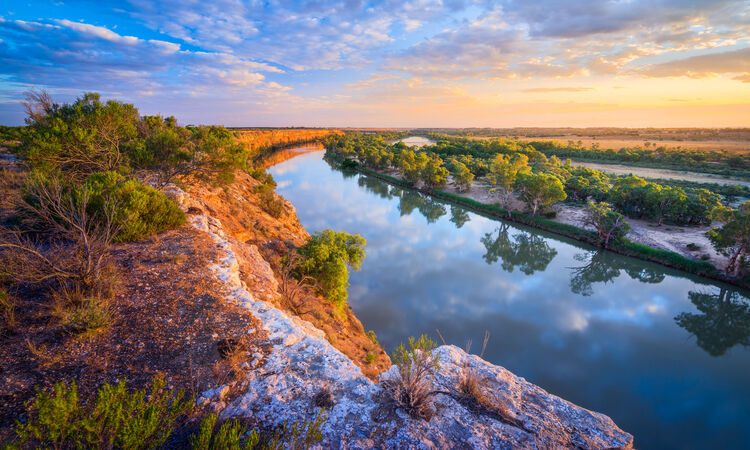Article content
24 October 2025 by David Warne
Australia is such a vast continent with a huge range of attractions, which makes choosing where to visit on a holiday an almost impossible task. Having been lucky enough to visit Australia a number of times over the years, I was able plan my most recent holiday around new experiences and destinations that might not make it into a first-time visitor’s itinerary.
Central to my trip was exploring South Australia, with my itinerary planned around two experiences, the legendary Ghan train and the less well-known Murray River Walk. The walk is recognised not only as one of the Great Walks of Australia but also a member of the Australian Wildlife Journeys collective, both of which part of the wider Signature Experiences of Australia programme, designed to showcase the very best of Australia to holidaymakers. This 4 day/3-night walk is unique in several ways, not least in that overnight accommodation is in a luxury houseboat that moors in a different location on the river each night. It also promises a taste of the Riverland region of South Australia, a fertile area thanks to irrigation from the Murray River that produces an astonishing array of foods and wines. The combination of varied landscapes, wildlife and walking and a taste of South Australia’s Riverland region seemed unbeatable.
Another great feature of the walk is that it is a family owned and operated business. Tony and Susie - proud Riverland locals with an extraordinary passion for the river - set up the business in 2016 and have won numerous awards since. I joined the first walk of the season in late April, and we were lucky enough to have Tony along on the trip as one of our guides.
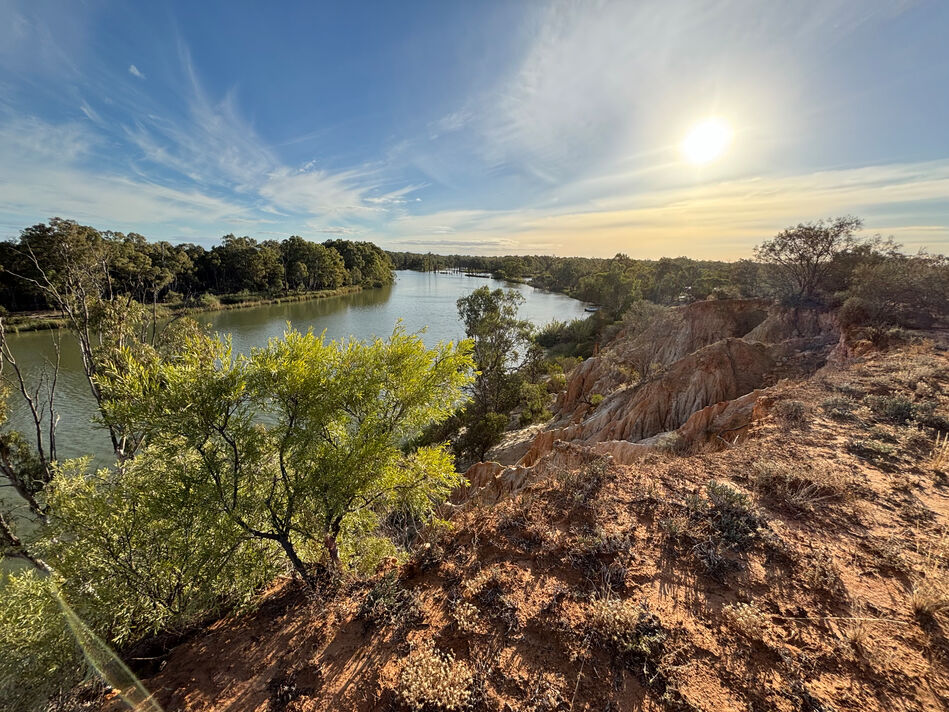
Scenery on the Murray River Walk
Day 1: Renmark to Headings Cliffs
The meeting point for the walk is the riverfront Renmark Hotel, the oldest community hotel in the world. Like many other guests we stayed there overnight prior to the walk, due to the 8am start. Whilst not a luxury hotel by any means, it has a prime location on the Renmark waterfront and is of historic interest. It also hosts a highly regarded fine-dining experience at the Temperance restaurant.
On the morning of departure, we met our guides and fellow guests - from Australia, New Zealand and the USA - in a private room at the hotel. After introductions and a briefing on the adventure ahead we kitted up and prepared for the off. Murray River Trails provide excellent equipment if needed, including Osprey backpacks, walking poles, water bottles, fruit, snacks and a packed lunch. A walk across the road to the riverbank brought us to our ‘cruiser’, a small but comfortable river boat which would take us for an hour or so on the river to the start of the walk itself. Our luggage was transported ahead to our houseboat, which we would see for the first time at the end of the first day’s walk.
During our leisurely ‘cruise’ along the river, our guides began introducing us to the fascinating history and ecology of the Murray River. Within minutes of starting our river journey we had already seen several bird species, including flocks of graceful pelicans, flighty Welcome Swallows and noisy Galahs. The river is also home to enormous and impressive river gum trees - some of which are hundreds of years old - which line the banks of the river as far as the eye can see. After being dropped off at the starting point of the walk, it soon became clear that we would not be following a designated path. The walk alternated between following riverbanks, dry creek beds, animal tracks and crossing flood plains. Our guide explained that the conditions, seasons and impact of past floods would to some degree dictate our route for the walk, so no two walks are ever exactly the same.
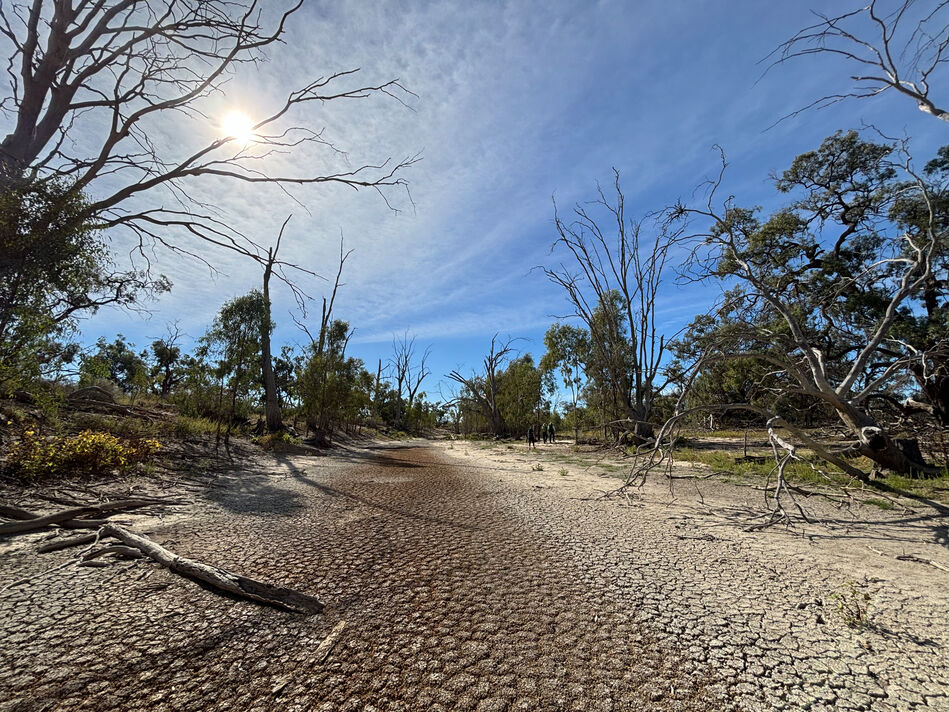
Dry riverbed seen during our walk
During the late morning and early afternoon we explored a varied landscape, with ancient trees and new saplings jostling for position along the banks of the river and its many creeks and ox-bow lakes. Our guides took the time to explain the varied flora and fauna in some detail, highlighting the impact of farming and irrigation in the Riverland region. From the route of the walk itself you would have no idea of the intensity of farming around the region, which is one of Australia’s most productive. Indeed, aside from a rare passing houseboat, this is very much a wilderness experience.
The extraordinary variety of bird species ensured that we stopped regularly to peer through the provided binoculars (you don’t have to be a twitcher to enjoy the sightings of so many colourful species). We also enjoyed regular sightings of rather comical wild emus, often running away from us at surprising speed.
A lunch break on the riverbank provided a rather welcome surprise. From seemingly out of nowhere, one of our hosts arrived on the cruiser to deliver a freshly baked, piping-hot flan to supplement the packed lunches we were carrying.
The afternoon introduced us to a completely different landscape of sand dunes, resplendent in the spectacular ochres that are such prominent a feature of the Australian outback. After a short climb heading away from the main river, we walked along the ridge of an escarpment with expansive views of the plains, before heading back to the river. We spotted kangaroos and yet more new bird species as the late afternoon sun started its descent to the horizon below. Arriving again at the river we were greeted with a splendid vista of red dunes, green trees, the silver river and our houseboat in the distance below, all painted orange by the setting sun. After enjoying the moment for a few minutes we descended to the riverbank, where our cruiser was waiting to ferry us to our nearby houseboat.
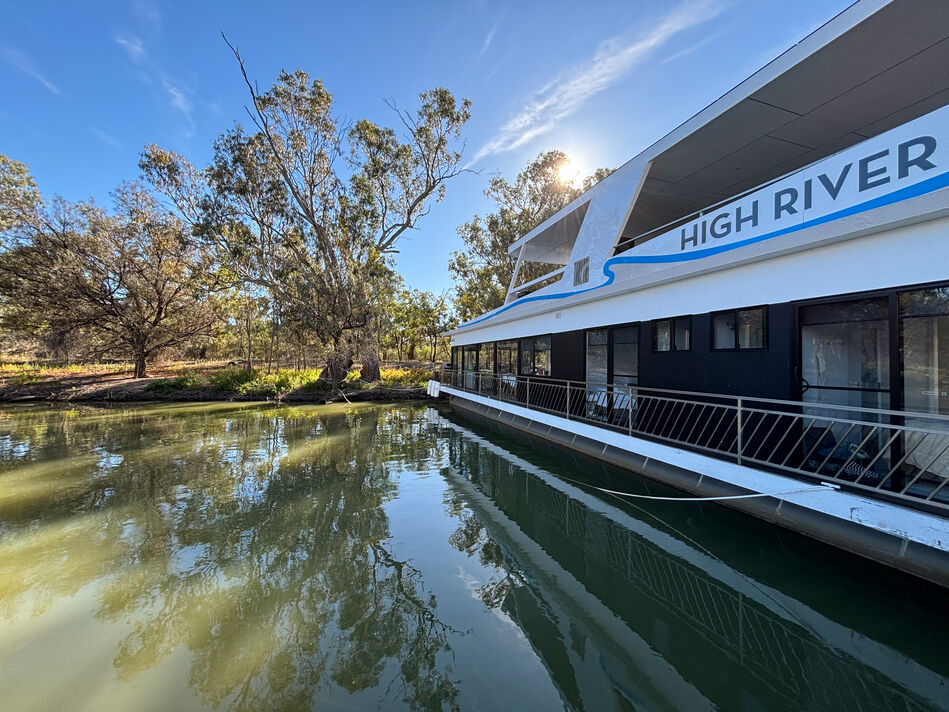
High River houseboat
Our floating home for the next three nights, called ‘High River’, turned out to be a state-of-the-art, solar powered vessel that was launched in 2023. In houseboat terms she is rather luxurious. Five compact but well-thought-out cabins accommodate a maximum of just 10 guests in some comfort, with either a twin or double configuration. Each cabin has plenty of storage space and unexpectedly spacious en-suite bathrooms, each with a large shower, toilet and sink. An open plan lounge-dining area with floor to ceiling windows all round allowed us to admire the beautiful riverscapes. Even better views are available from the upper deck, which is covered, but otherwise open to the elements on all sides.
During the hour or so before dinner ‘Riverland nibbles’ were served, with a selection of drinks. Indeed, all of the produce and drinks served onboard are locally sourced from respected Riverland producers. There was ample time to enjoy the last of the sunset and to chat to fellow guests over a drink, whilst dipping our feet in the river from the rear deck.
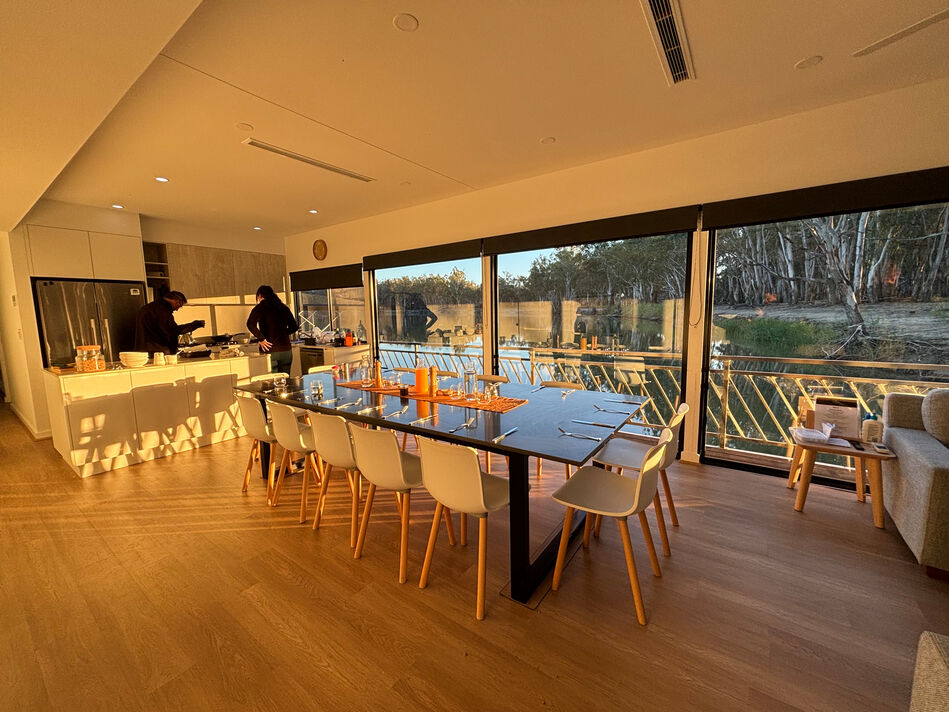
Dining area – High River
Then, after changing out of our trekking gear and enjoying a well-earned shower we joined our fellow guests and crew for dinner. Meals were also locally sourced, with menus created by award-winning South Australian chef and writer, Andrew Fielke, one of the pioneers of using native Australian ingredients in contemporary cuisine. Seated around a communal table together with our guides we enjoyed the first of what would be three superb wine-paired dinners. We enjoyed a delicious starter of Murray Cod chowder paired with a crisp 2021 Whistling Kite Biodynamic Viognier, followed by a super-tender Sous-vide Kangaroo fillet paired with a 2022 Starrs Reach Confluence Mataro Durif. As dinner progressed and we stared to get to know each other, the conversation flowed easily. A Quandong Pie with vanilla ice cream, followed by a night cap rounded off a highly enjoyable evening.
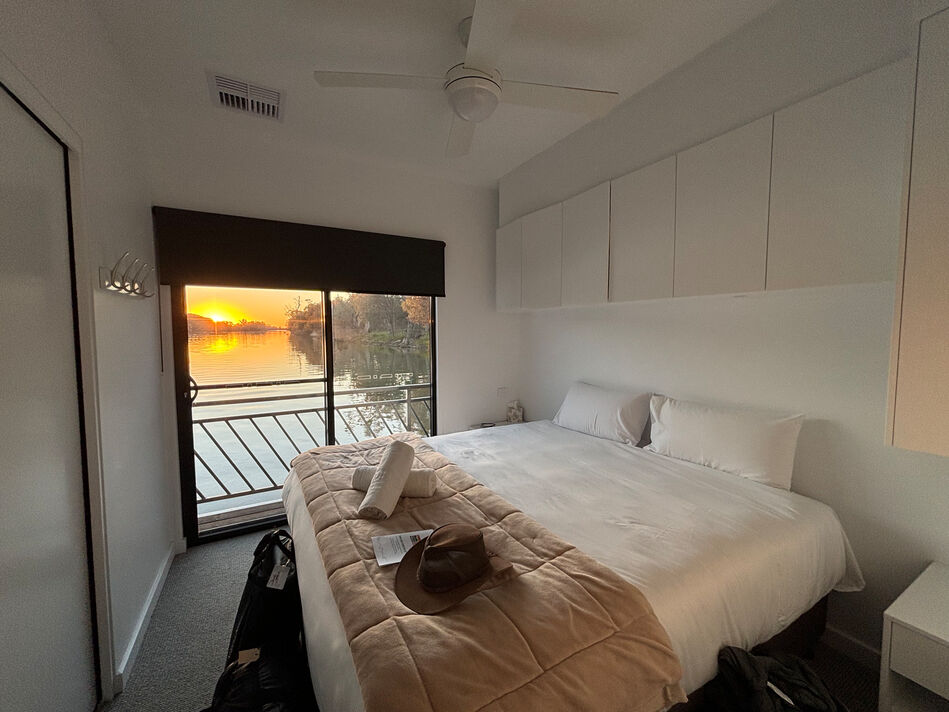
Guest bedroom – High River
Day 2: Headings Cliffs to Chowilla Creek
We set off before dawn armed with torches for a short walk to a lookout to enjoy sunrise, carefully ascending a steep slope to the crest of the dunes. Whilst walking along the ridge, the early morning light progressively unveiled even more dramatic views than we had seen the evening before. From the lookout, we enjoyed a spectacular show, with the morning sky graduating from deep orange through pink and then finally deep blue as the sun rose. Over coffee and cookies, we learned about the surprisingly complex geology of region, the coloured layers in the sandstone escarpment having been created over time by action of the seas and lakes that once covered this area.
We returned to High River for breakfast, pausing at a thicket of tall trees hosting a riot of different bird species enjoying the morning. After a hearty breakfast we set off for the main walk of the day at around 9am. Our route would take us away from the main river to explore the many ox-bow lakes, creeks and floodplains. A major highlight of today’s walk was discovering sites of historical aboriginal activity on the river. It is estimated that aboriginal Australians first came to this area of the river between 25,000 and 30,000 years ago and we saw evidence of middens and stone tools. But perhaps most impressive was the sight of trees bearing oval-shaped scars where shields, bowls and even canoes had been cut from the bark of ancient trees. We also saw ‘ring trees’, where aboriginal clans had tied branches together to form a ‘ring’ to mark the edge of their territory.
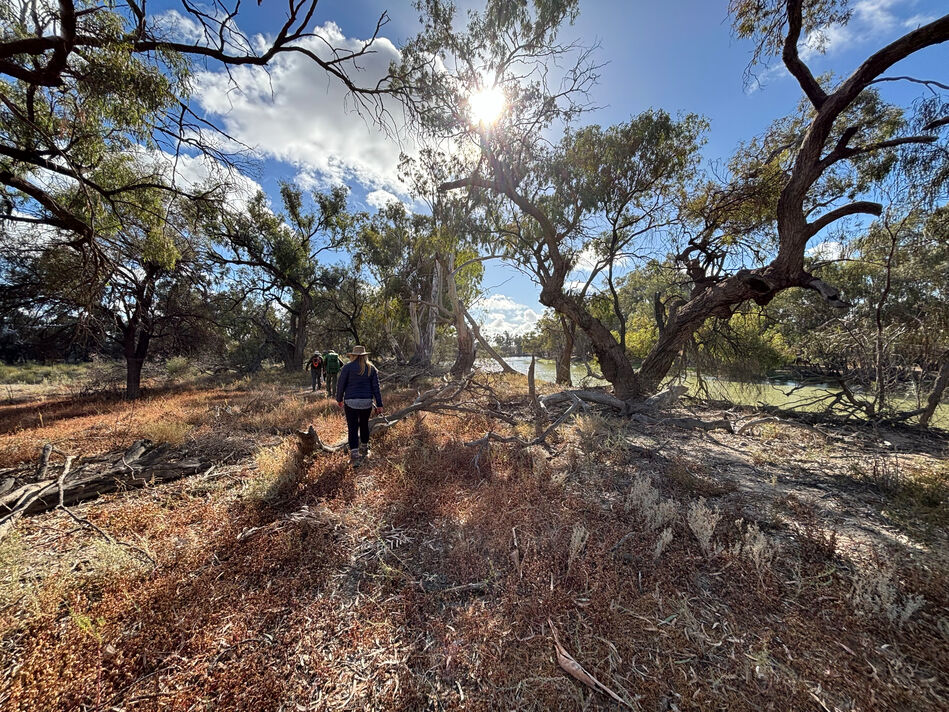
Scenery along the Murray River
The walking was adventurous today, at times meandered through the bush, well away from any clear path. We even crossed creeks with makeshift bridges of dead branches. The bird species count continued to soar – a particular highlight was the sighting of Regent Parrots. High River had moved on ahead of us to a new location for this evening, in a thickly forested section of the river. After a 14km walk we were all pleased to see her. On arrival, we were introduced to a regular visitor in this area - the inquisitive Eric the Egret - who would perch on the railing of the houseboat and knock at the glass of our cabins with his beak. Dinner for the second evening started with a carrot, sweet potato and lemon myrtle soup, which was followed by a rich and tasty Massaman beef curry, paired with a superb 2020 Bassham Organic Montepulciano red.
Day 3: Chowilla Creek to Bunyip Reach Cliffs
After breakfast we had an in-depth presentation on the greater Murray-Darling river system and the impact of human intervention on the landscape. Incredibly, the combined area of the systems around the two rivers covers more than 1 million square kilometres across 5 Australian states. We learned that the waters originate from rainfall in the Great Dividing Range before flowing into the Great Southern Ocean near Goolwa, in South Australia. Over the past 150 years dams and irrigation projects upstream have reduced the flow considerably in the Riverland region. South Australia hosts the smallest part of the Murray Darling basin but has always been the area most impacted by human action. Currently only 10% of the total flow reaches the sea in South Australia; prior to the building of locks and weirs up to 90% used to discharge into the ocean. Indeed, much of the recent past has been marked by tension between the conflicting needs of agriculture, tourism, the environment and aboriginal societies.
In 1960 the then South Australian premier, Tom Playford, proposed the construction of a dam at Chowilla, to regulate the floods and provide more reliable water supplies. However, the project was eventually abandoned due to fears of increased salinity and wider environmental concerns. Instead, the decision was made to essentially allow certain areas in the river system to ‘rewild’. One of these areas is the Chowilla creek system, which today hosts the Chowilla Game Reserve. Our walk took us through the Chowilla area that would have been completely submerged should the dam have been built.
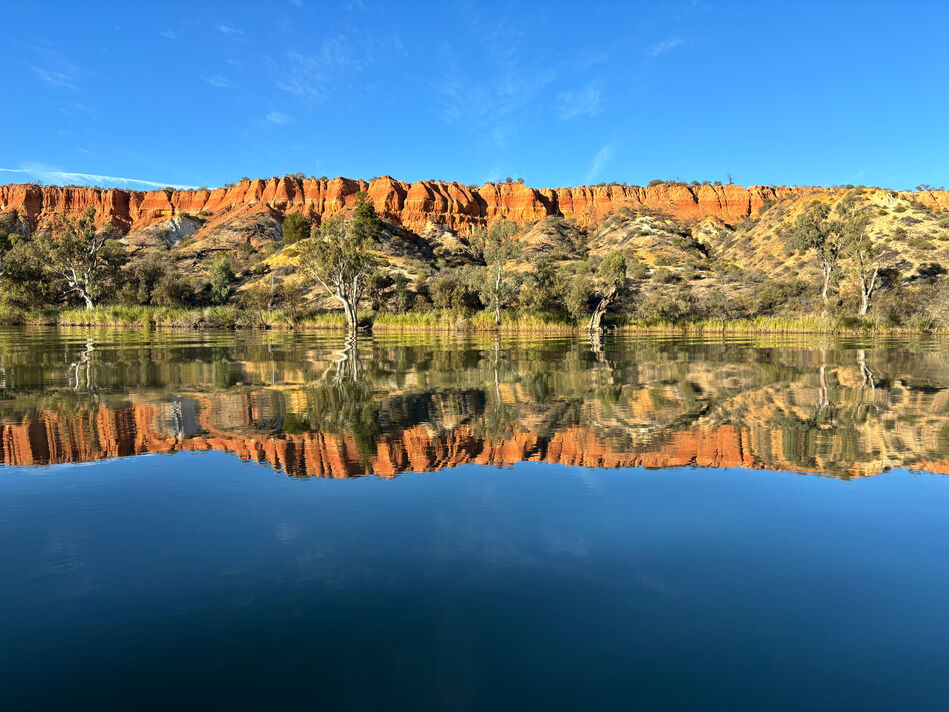
Murray River scenery
We walked alongside Chowilla creek and saw examples of the positive impact of new regulator systems where the flood plains have been left to regenerate. Dead trees left in place in the creeks have become rich habitats for fish. Ingenious ‘fish ladders’ have been installed at locks and weirs, allowing fish to continue to swim upriver to spawn. Whilst walking across the flood plains in the area we spotted kangaroos and emus, before taking a meandering route through thick undergrowth to the riverbank to meet our cruiser. After a short ride across the river, we ascended Bunyip Cliff for the final section of the walk along the top of the red sand cliffs. Shortly before the end of this truly spectacular section of the walk, Tony showed us an artist’s impression of what the area would have looked like should the dam have been built. Essentially, the vast majority of the now flourishing habitat we had walked through would have been completely submerged. The walk ended atop the spectacular Bunyip Reach Cliffs where a pop-up bar had been prepared for us to enjoy the view with a few sundowners, a fitting way to celebrate the end of a rather wonderful three days’ walking. As the sun began to set, we made our way down the cliff and returned to the nearby houseboat which was, as always, moored in a wonderfully scenic spot.
In the evening, a campfire was prepared on the riverbank close to the houseboat, for guests and guides to share our experiences of the last few days before our farewell dinner, which was possibly the most enjoyable of the trip. We enjoyed a wonderful Murray Cod fillet with Lemon Myrtle Panko crust followed by an Orange and Lemon Myrtle Duck, again paired with Riverland wines, including an excellent 2022 Ricca Terra Soldiers Land Grenache.
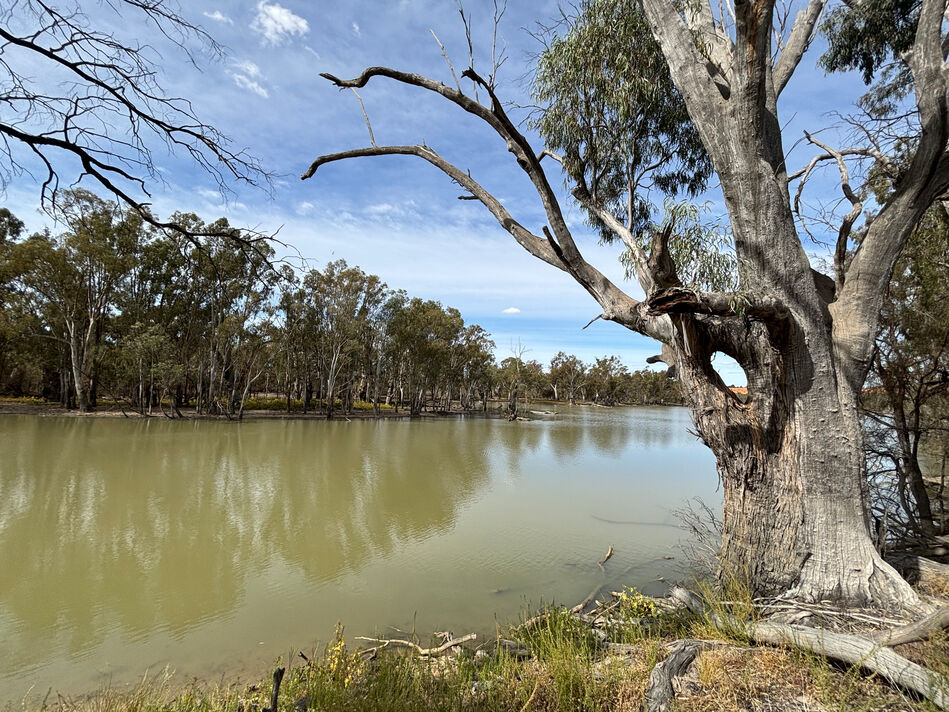
'Ring tree' along the Murray River
Day 4: Bunyip Reach to Renmark
With the formal walking trail completed, the final half-day of the experience was a leisurely affair. After a relaxed breakfast we took a short self-guided walk along the riverbank for half an hour before being picked up by cruiser and returned to the houseboat in time to be taken through one of the locks heading back towards Renmark. Notable along this stretch of the river are the huge willows trees introduced from Europe, giving the river here an unexpectedly English aspect. During our cruise on the houseboat back towards Renmark, we packed and then relaxed over coffee before ending our experience at the Woolshed Brewery for a barbecue lunch. This converted woolshed, with its scenic riverside location, has become something of a local hotspot for casual dining and drinks. The on-site brewery produces a huge range of craft beers and ales, so it was fitting to be able to toast the end of our journey with a final taste of the Riverland. A final short transfer took us back to Renmark, where we bid farewell to our fellow guests and went our separate ways.
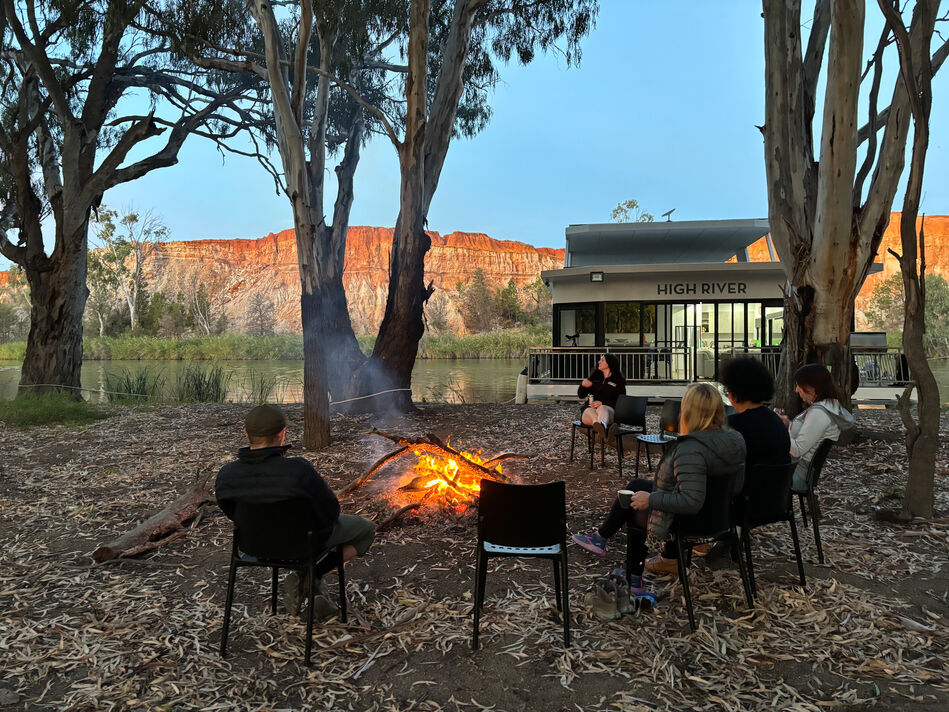
Riverside camp fire, Murray River Walk
Closing thoughts:
The Murray River Walk is not just a uniquely Australian experience but a uniquely South Australian one. With all produce served on board coming from this highly productive region – thanks in no small part to the Murray River itself – the experience was a wonderful immersion into the Riverland region of the Murray River. Our houseboat, High River, was integral to the experience. Being fully solar-powered - and therefore completely silent when not moving – meant we could really enjoy the tranquillity of the evenings. A good night’s sleep was all but guaranteed.
But above all, our guides and hosts really brought the area to life. Their passion for the region was infectious and by the end I felt I had received an education as well as having a lot of fun.
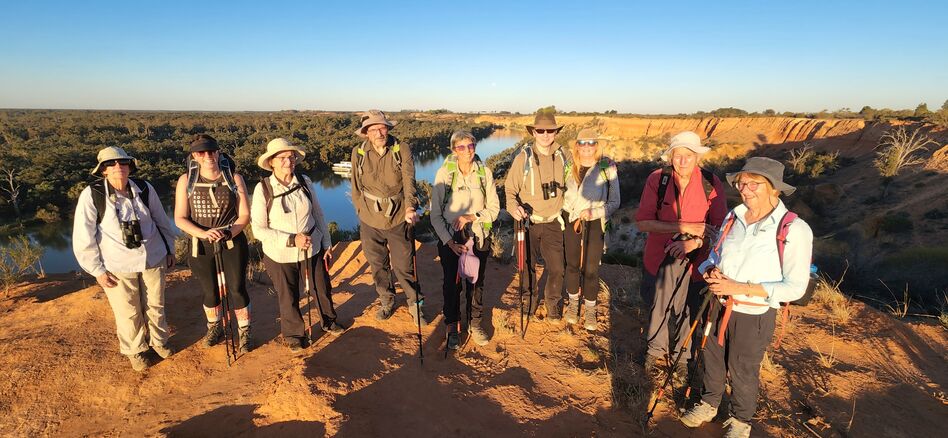
Our group on the Murray River Walk
Good to know:
The Murray River Walk season runs from late April or early May to September, when the climate is cooler, stable and dry. Indeed, this is a very dry region in Australia’s driest state, so rainfall is a rarity on the walk. A degree of fitness is, of course, required for this experience - we walked for around 8 or 9 miles on each of the three days of the walk - but the pace was leisurely and much of the walk was on flat ground.
This is an enriching and immersive adventure in an area often overlooked by international visitors, which is a shame, it comes highly recommended and certainly ranks amongst one of my all-time favourite Australian experiences.

